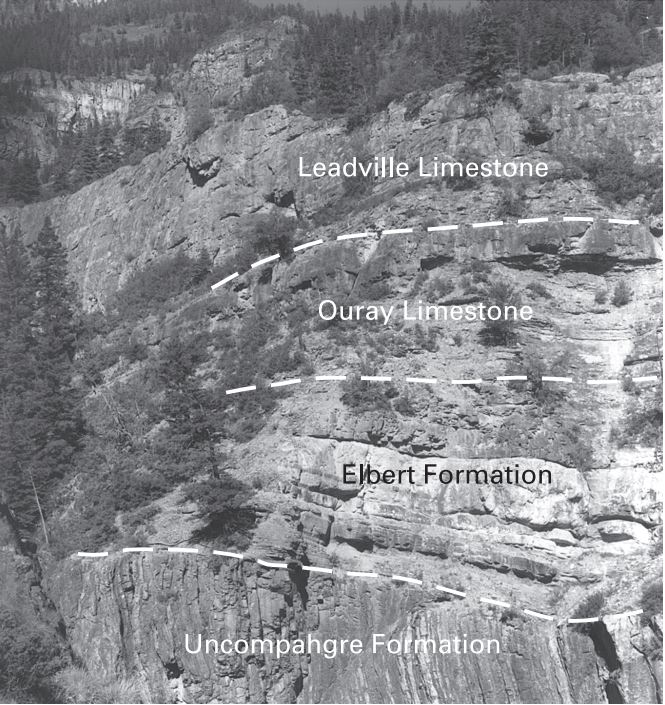Leadville Limestone on:
[Wikipedia]
[Google]
[Amazon]
 The Leadville Limestone is a Mississippian
The Leadville Limestone is a Mississippian
Gaskill, D.L., and Godwin, L.H., 1966. USGS Geologic Quadrangle Map GQ-512. Map Scale: 1:24,000. InGeology of Glenwood Springs Quadrangle and Vicinity, Northwestern Colorado
By N. Wood Bass and Stuart A. Northrop, 1963. GEOLOGICAL SURVEY BULLETIN 1142-J. pp. J26-J29. A metamorphic facies of this formation is known as the
 The Leadville Limestone is a Mississippian
The Leadville Limestone is a Mississippian geologic formation
A geological formation, or simply formation, is a body of rock having a consistent set of physical characteristics ( lithology) that distinguishes it from adjacent bodies of rock, and which occupies a particular position in the layers of rock exp ...
in the western United States
The United States of America (U.S.A. or USA), commonly known as the United States (U.S. or US) or America, is a country primarily located in North America. It consists of 50 states, a federal district, five major unincorporated territori ...
.Geologic map of the Marble quadrangle, Gunnison and Pitkin Counties, ColoradoGaskill, D.L., and Godwin, L.H., 1966. USGS Geologic Quadrangle Map GQ-512. Map Scale: 1:24,000. In
Colorado
Colorado (, other variants) is a state in the Mountain states, Mountain West subregion of the Western United States. It encompasses most of the Southern Rocky Mountains, as well as the northeastern portion of the Colorado Plateau and the wes ...
, the upper part is oolitic limestone
Limestone ( calcium carbonate ) is a type of carbonate sedimentary rock which is the main source of the material lime. It is composed mostly of the minerals calcite and aragonite, which are different crystal forms of . Limestone forms whe ...
, while the lower part is primarily dolomite Dolomite may refer to:
*Dolomite (mineral), a carbonate mineral
*Dolomite (rock), also known as dolostone, a sedimentary carbonate rock
*Dolomite, Alabama, United States, an unincorporated community
*Dolomite, California, United States, an unincor ...
, and somewhat sandy beds indicate the bottom of the formation.
The formation is sparsely fossiliferous
A fossil (from Classical Latin , ) is any preserved remains, impression, or trace of any once-living thing from a past geological age. Examples include bones, shells, exoskeletons, stone imprints of animals or microbes, objects preserved ...
but contains many calcareous algae, Foraminifera
Foraminifera (; Latin for "hole bearers"; informally called "forams") are single-celled organisms, members of a phylum or class of amoeboid protists characterized by streaming granular ectoplasm for catching food and other uses; and commonly ...
('' Endothyra''), sponges, corals
Corals are marine invertebrates within the class Anthozoa of the phylum Cnidaria. They typically form compact colonies of many identical individual polyps. Coral species include the important reef builders that inhabit tropical oceans and secr ...
('' Syringopora''), Bryozoa
Bryozoa (also known as the Polyzoa, Ectoprocta or commonly as moss animals) are a phylum of simple, aquatic invertebrate animals, nearly all living in sedentary colonies. Typically about long, they have a special feeding structure called a ...
, many brachiopods
Brachiopods (), phylum Brachiopoda, are a phylum of trochozoan animals that have hard "valves" (shells) on the upper and lower surfaces, unlike the left and right arrangement in bivalve molluscs. Brachiopod valves are hinged at the rear end, wh ...
, gastropods
The gastropods (), commonly known as snails and slugs, belong to a large taxonomic class of invertebrates within the phylum Mollusca called Gastropoda ().
This class comprises snails and slugs from saltwater, from freshwater, and from land. The ...
('' Bellerophon'', ''Straparolus''), Cephalopoda
A cephalopod is any member of the molluscan class Cephalopoda (Greek plural , ; "head-feet") such as a squid, octopus, cuttlefish, or nautilus. These exclusively marine animals are characterized by bilateral body symmetry, a prominent hea ...
, fragments of ostracods
Ostracods, or ostracodes, are a class of the Crustacea (class Ostracoda), sometimes known as seed shrimp. Some 70,000 species (only 13,000 of which are extant) have been identified, grouped into several orders. They are small crustaceans, typical ...
, abundant fragments of crinoids
Crinoids are marine animals that make up the class Crinoidea. Crinoids that are attached to the sea bottom by a stalk in their adult form are commonly called sea lilies, while the unstalked forms are called feather stars or comatulids, which are ...
, echinoid
Sea urchins () are spiny, globular echinoderms in the class Echinoidea. About 950 species of sea urchin live on the seabed of every ocean and inhabit every depth zone from the intertidal seashore down to . The spherical, hard shells (tests) of ...
spines, and teeth of fish
Fish are aquatic, craniate, gill-bearing animals that lack limbs with digits. Included in this definition are the living hagfish, lampreys, and cartilaginous and bony fish as well as various extinct related groups. Approximately 95% of ...
.By N. Wood Bass and Stuart A. Northrop, 1963. GEOLOGICAL SURVEY BULLETIN 1142-J. pp. J26-J29. A metamorphic facies of this formation is known as the
Yule Marble
Yule Marble is a marble of metamorphosed Leadville Limestone found only in the Yule Creek Valley, in the West Elk Mountains of Colorado, southeast of the town of Marble, Colorado.Marble Quadrangle, Colorado; USGS 7.5-minute series topograp ...
and has been quarried for construction materials.
See also
* List of fossiliferous stratigraphic units in Colorado *Paleontology in Colorado
The location of the state of Colorado
Paleontology in Colorado refers to paleontological research occurring within or conducted by people from the U.S. state of Colorado.
The geologic column of Colorado spans about one third of Earth's history ...
References
Carboniferous Colorado Carboniferous southern paleotropical deposits {{Carboniferous-stub